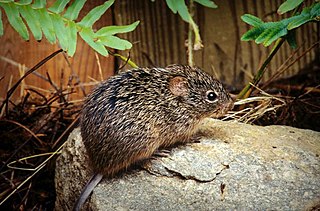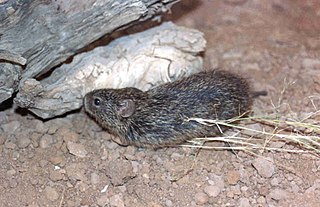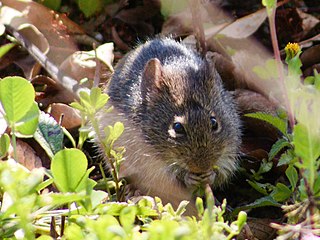
The rodent subfamily Sigmodontinae includes New World rats and mice, with at least 376 species. Many authorities include the Neotominae and Tylomyinae as part of a larger definition of Sigmodontinae. When those genera are included, the species count numbers at least 508. Their distribution includes much of the New World, but the genera are predominantly South American, such as brucies. They invaded South America from Central America as part of the Great American Interchange near the end of the Miocene, about 5 million years ago. Sigmodontines proceeded to diversify explosively in the formerly isolated continent. They inhabit many of the same ecological niches that the Murinae occupy in the Old World.

Gregory Antone Prince is an American pathology researcher, businessman, author, social critic, and historian of the Latter Day Saint movement.

Oligoryzomys fulvescens, also known as the fulvous colilargo, fulvous pygmy rice rat, or northern pygmy rice rat, is a species of rodent in the genus Oligoryzomys of family Cricetidae. It is found from southern Mexico through Central America into South America, where it occurs south into Peru and Brazil, and includes numerous synonyms, including the type species of the genus, Oryzomys navus Bangs, 1899. The taxonomy of this species is unresolved, and it may be found to contain more than one species. Its karyotype has 2n = 54-60 and FNa = 68–74.

The hispid cotton rat is a rat long thought to occur in parts of South America, Central America, and southern North America. However, recent taxonomic revisions, based on mitochondrial DNA sequence data, have split this widely distributed species into three separate species. The distribution of S. hispidus ranges from Arizona in the west to Virginia to the east and from the Platte River in Nebraska in the north to, likely, the Rio Grande in the south, where it meets the northern edge of the distribution of S. toltecus. Adult size is total length 202–340 mm (8.0–13.4 in); tail 87–122 mm (3.4–4.8 in), frequently broken or stubbed; hind foot 29–35 mm (1.1–1.4 in); ear 16–20 mm (0.63–0.79 in); mass 50–250 g (1.8–8.8 oz). They have been used as laboratory animals.

The tawny-bellied cotton rat is a species of rodent in the family Cricetidae. It is found in Mexico and in the US states of Arizona and New Mexico.

The Jaliscan cotton rat or Mexican cotton rat is a species of rodent in the family Cricetidae. It is found only in Mexico. They commonly have brown fur with white fur on the belly. They are ground-dwelling and prefer open habitats.

The yellow-nosed cotton rat is a species of rodent in the family Cricetidae. It is native to Mexico and to the states of Arizona, New Mexico, and Texas in the United States, where it inhabits mountain grassland, scrub, and pinyon-juniper woodland. It is common over much of its wide range and the IUCN considers it to be of "least concern".
The Toltec cotton rat is a rodent species in the family Cricetidae. It is found in eastern Mexico from the Rio Grande to the Yucatán Peninsula, as well as in Belize and northern Guatemala. It prefers moist grassland habitat. While long thought to be a subspecies of S. hispidus, recent taxonomic revisions, based on mitochondrial DNA sequence data, have split the extensive former species range into three separate species. Carroll et al. (2004) indicate that the southern edge of the S. hispidus distribution is likely near the Rio Grande where it meets the northern distribution of S. toltecus. The range of S. toltecus extends from northern Mexico south into Chiapas where it occurs in sympatry with S. hirsutus . Rats from this species group have been used as laboratory animals.

The southern cotton rat is a rodent species in the family Cricetidae. It is found from southern Chiapas in Mexico through Central America, except for Belize, and as far east as northern Colombia and Venezuela. It lives in tropical rainforest, dry forest and savanna, as well as in cultivated areas. The species is terrestrial and primarily diurnal. It was long thought to be a subspecies of S. hispidus. However, recent taxonomic revisions, based on mitochondrial DNA sequence data, have split the extensive former species range into three separate species. Carroll et al. (2004) indicate that the southern edge of the S. hispidus distribution is likely near the Rio Grande where it meets the northern distribution of S. toltecus. The range of S. toltecus extends from northern Mexico south into Chiapas where it occurs in sympatry with S. hirsutus . Rats from this species group have been used as laboratory animals.
Taenia rileyi is a tapeworm of the genus Taenia from the United States. Adults infect bobcats and feral domestic cats, but larvae have been found in rodents such as the cotton mouse, the marsh rice rat in Florida, and the hispid cotton rat in Florida and Georgia. These rodents may serve as intermediate hosts.
Taenia mustelae is a tapeworm of the genus Taenia from the United States. Adults infect carnivorans such as weasels, skunks, and martens, but larvae have been found in rodents such as the Florida mouse and the marsh rice rat in Florida and the hispid cotton rat in Florida and Georgia. These rodents may serve as intermediate hosts.
Mastophorus muris is a parasitic nematode in the genus Mastophorus. It infects animals such as the marsh rice rat, hispid cotton rat, and singing vole.
Prolistrophorus bakeri is a parasitic mite in the genus Prolistrophorus. Together with the Argentine P. hirstianus, it forms the subgenus Beprolistrophorus. P. bakeri has been found on the hispid cotton rat, marsh rice rat, and cotton mouse in Georgia, South Carolina, Texas, and Florida and on Oryzomys couesi in Colima. It was formerly placed in the genus Listrophorus.
Pterygodermatites ondatrae is a species of parasitic nematode in the genus Pterygodermatites. It has been recorded in the hispid cotton rat in Florida and Texas. In Florida, it has also been recorded on the marsh rice rat, together with an unnamed species of the same genus, the female of which cannot be distinguished from that of P. ondatrae.
Physaloptera hispida is a parasitic nematode in the genus Physaloptera. It has been found on the marsh rice rat, hispid cotton rat, Florida mouse, cotton mouse, and oldfield mouse in Florida.
Trichostrongylus affinis is a species of parasitic nematode in the genus Trichostrongylus. It primarily infects cottontails (Sylvilagus), but has also been found in the hispid cotton rat and the marsh rice rat.
Trichostrongylus sigmodontis is a species of parasitic nematode in the genus Trichostrongylus. It primarily infects the hispid cotton rat, but has also been found in the marsh rice rat.
Playa de Oro virus (OROV) is a probable species of orthohantavirus found in the rodents Oryzomys couesi and Sigmodon mascotensis in the Mexican state of Colima. The former is thought to be the main host. The sequences of parts of the virus's RNA-based genome have been determined; they differ by 7–10% in amino acid composition and 22–24% in nucleotide composition from closely related viruses.







